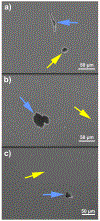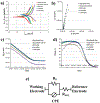Microstructure and electrochemical behavior of contemporary Ti6Al4V implant alloys
- PMID: 35911172
- PMCID: PMC9328449
- DOI: 10.1007/s40735-021-00623-3
Microstructure and electrochemical behavior of contemporary Ti6Al4V implant alloys
Abstract
Ti6Al4V is the most common titanium alloy within the biomaterial field. While material standards for different variations of this alloy exist, there are only minimal requirements with respect to its microstructure which is directly related to the alloy's properties. Thus, a better understanding of the Ti6Al4V microstructure of common contemporary implant components and its effect on the electrochemical behavior is needed; including additively manufactured (AM) devices. Therefore, this study aimed at characterizing the microstructures of conventional and AM total joint replacement components, and to identify the effect of microstructure on the electrochemical behavior. Thus, 22 components from conventional (surgically retrieved cast and wrought implants) and AM implants (not previously implanted) were analysed to characterize microstructure by means of electron backscatter diffraction (EBSD) and energy dispersive X-Ray spectroscopy (EDS), and tested to determine its electrochemical behavior (potentiodynamic polarization and EIS). The microstructure of the conventional implants varied broadly but could be categorized into four groups as to their grain size and shape: fine equiaxed, coarse equiaxed, bimodal, and lamellar. The AM components exhibited a fifth category: lath-type. The AM components had a network of β-phase along the α-phase grain boundaries, prior β-grains, and manufacturing voids. Finally, the electrochemical study showed that the equiaxed coarse grains and lath-type grains (AM components) had inferior electrochemical behavior, whereas cast alloys had superior electrochemical behaviour; fine-grained wrought alloys likely provide the best compromise between electrochemical and mechanical properties.
Keywords: Ti6Al4V; additive manufacturing; corrosion behavior; implant alloy microstructure; total joint replacements.
Conflict of interest statement
7. Conflict of interest Nicholas B. Frisch (Zimmer Biomet), Mathew T. Mathew (MicroPort Ortho), Alfons Fischer (Zimmer Biomet, Biotronic, Aesculap, ATI), Joshua J. Jacobs (Medtronic Sofamor Danek, Nuvasive and Zimmer Biomet), Robin Pourzal (Zimmer Biomet).
Figures









Similar articles
-
Alloys Used in Different Temporomandibular Joint Reconstruction Replacement Prostheses Exhibit Variable Microstructures and Electrochemical Properties.J Oral Maxillofac Surg. 2022 May;80(5):798-813. doi: 10.1016/j.joms.2021.12.016. Epub 2021 Dec 30. J Oral Maxillofac Surg. 2022. PMID: 35157828
-
Alloy Microstructure Dictates Corrosion Modes in THA Modular Junctions.Clin Orthop Relat Res. 2017 Dec;475(12):3026-3043. doi: 10.1007/s11999-017-5486-3. Epub 2017 Sep 7. Clin Orthop Relat Res. 2017. PMID: 28884275 Free PMC article.
-
Microstructural examination and corrosion behavior of selective laser melted and conventionally manufactured Ti6Al4V for dental applications.Mater Sci Eng C Mater Biol Appl. 2020 Aug;113:110980. doi: 10.1016/j.msec.2020.110980. Epub 2020 Apr 19. Mater Sci Eng C Mater Biol Appl. 2020. PMID: 32487394
-
Effects of Shot Peening and Electropolishing Treatment on the Properties of Additively and Conventionally Manufactured Ti6Al4V Alloy: A Review.Materials (Basel). 2024 Feb 17;17(4):934. doi: 10.3390/ma17040934. Materials (Basel). 2024. PMID: 38399186 Free PMC article. Review.
-
A review of the corrosion behavior of conventional and additively manufactured nickel-aluminum bronze (NAB) alloys: current status and future challenges.Mater Horiz. 2023 Nov 27;10(12):5391-5435. doi: 10.1039/d3mh00951c. Mater Horiz. 2023. PMID: 37789823 Review.
Cited by
-
Study of Microstructural Morphology of Ti-6Al-4V Alloy by Crystallographic Analysis and Phase Field Simulation.Materials (Basel). 2022 Aug 2;15(15):5325. doi: 10.3390/ma15155325. Materials (Basel). 2022. PMID: 35955256 Free PMC article.
References
-
- Liu S; Shin YC Additive Manufacturing of Ti6Al4V Alloy: A Review. Mater. Des 2019, 164, 107552. 10.1016/j.matdes.2018.107552. - DOI
-
- Azarniya A; Colera XG; Mirzaali MJ; Sovizi S; Bartolomeu F; St Weglowski M., k; Wits WW; Yap CY; Ahn J; Miranda G; Silva FS; Madaah Hosseini HR; Ramakrishna S; Zadpoor AA Additive Manufacturing of Ti–6Al–4V Parts through Laser Metal Deposition (LMD): Process, Microstructure, and Mechanical Properties. J. Alloys Compd 2019, 804, 163–191. 10.1016/j.jallcom.2019.04.255. - DOI
-
- Niinomi M; Boehlert CJ Titanium Alloys for Biomedical Applications. In Advances in Metallic Biomaterials: Tissues, Materials and Biological Reactions; Niinomi M, Narushima T, Nakai M, Eds.; Springer Series in Biomaterials Science and Engineering; Springer: Berlin, Heidelberg, 2015; pp 179–213. 10.1007/978-3-662-46836-4_8. - DOI
-
- Guo L; Fan X; Yu G; Yang H Microstructure Control Techniques in Primary Hot Working of Titanium Alloy Bars: A Review. Chin. J. Aeronaut 2016, 29 (1), 30–40. 10.1016/j.cja.2015.07.011. - DOI
Grants and funding
LinkOut - more resources
Full Text Sources
Miscellaneous
